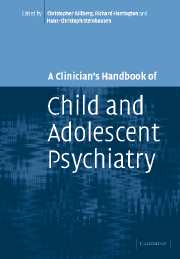Book contents
- Frontmatter
- Contents
- Preface
- List of contributors
- 1 Brain disorders
- 2 Substance use disorders
- 3 Schizophrenia and schizophrenia-like disorders
- 4 Affective disorders
- 5 Anxiety disorders
- 6 Obsessive-compulsive disorders
- 7 Adjustment disorders
- 8 Post-traumatic stress disorder
- 9 Functional somatic symptoms and somatoform disorders in children
- 10 Eating disorders: anorexia nervosa and bulimia nervosa
- 11 Sleep disorders
- 12 Personality disorders
- 13 Mental retardation/learning disability
- 14 Specific developmental disorders of speech and language
- 15 Reading and other learning disorders
- 16 Autism spectrum disorders
- 17 Hyperkinetic disorders
- 18 Conduct disorders
- 19 Elective mutism
- 20 Attachment and disorders of attachment
- 21 Tic disorders
- 22 Elimination disorders: enuresis and encopresis
- 23 Physical and sexual abuse
- 24 Gender identity disorders
- Index
- References
22 - Elimination disorders: enuresis and encopresis
Published online by Cambridge University Press: 06 August 2009
- Frontmatter
- Contents
- Preface
- List of contributors
- 1 Brain disorders
- 2 Substance use disorders
- 3 Schizophrenia and schizophrenia-like disorders
- 4 Affective disorders
- 5 Anxiety disorders
- 6 Obsessive-compulsive disorders
- 7 Adjustment disorders
- 8 Post-traumatic stress disorder
- 9 Functional somatic symptoms and somatoform disorders in children
- 10 Eating disorders: anorexia nervosa and bulimia nervosa
- 11 Sleep disorders
- 12 Personality disorders
- 13 Mental retardation/learning disability
- 14 Specific developmental disorders of speech and language
- 15 Reading and other learning disorders
- 16 Autism spectrum disorders
- 17 Hyperkinetic disorders
- 18 Conduct disorders
- 19 Elective mutism
- 20 Attachment and disorders of attachment
- 21 Tic disorders
- 22 Elimination disorders: enuresis and encopresis
- 23 Physical and sexual abuse
- 24 Gender identity disorders
- Index
- References
Summary
Introduction
Enuresis and encopresis are common disorders of childhood with a high spontaneous cure rate. They are therefore often considered to be ‘developmental disorders’. They are associated with high emotional distress for children and parents, as well as with increased rates of co-morbid behavioural disorders. Especially in daytime wetting, somatic symptoms such as urinary tract infections often co-exist. Therefore, a detailed assessment of both somatic and psychological aspects is essential to ensure an optimal and specific treatment.
In addition, several distinct subtypes of elimination disorders have been identified, which differ according to their aetiology, pathophysiology and clinical features.
Enuresis
Definition and classification
The main features according to both the ICD-10 and DSM-IV classification schemes are:
involuntary wetting at night or during daytime
from the age of 5 years onwards
after organic causes have been ruled out.
The differences between the two classifications systems regarding:
the duration of the wetting, which is shorter in DSM-IV (3 months) than in ICD-10 (6 months)
the frequency of wetting of two or more times per week or the alternative and less stringent criteria of high emotional stress according to DSM-IV; in contrast, children under 7 years need to wet two or more times per month, and those over 7 years only once a month to be considered to have enuresis according to ICD-10.
In contrast to these two official classification schemes, voluntary wetting is often a reflection of severe psychopathology and should not be termed ‘enuresis’.
- Type
- Chapter
- Information
- A Clinician's Handbook of Child and Adolescent Psychiatry , pp. 625 - 654Publisher: Cambridge University PressPrint publication year: 2006
References
- 2
- Cited by



